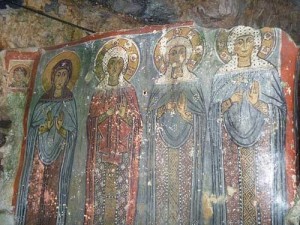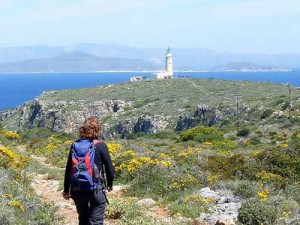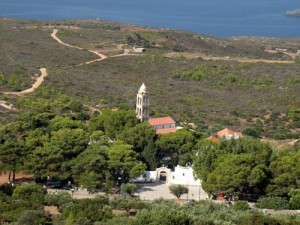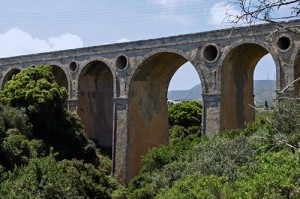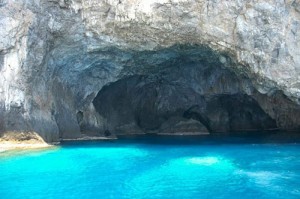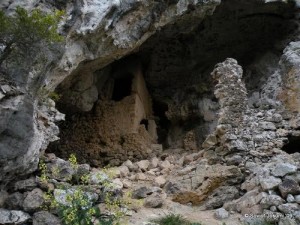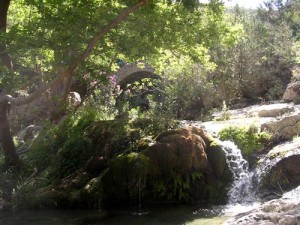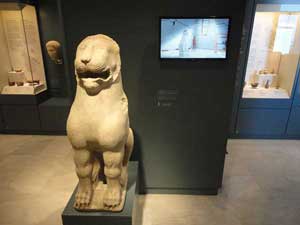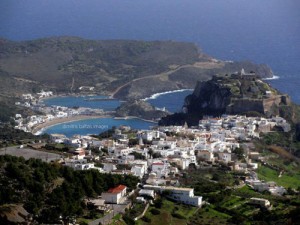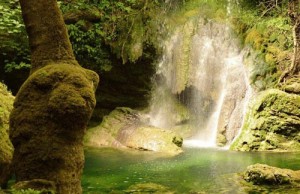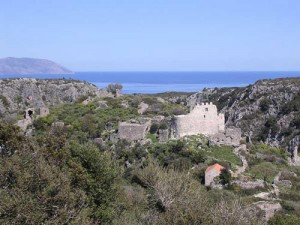Traduzione italiana in corso
Cave of Santa Sofia
Agia Sofia
The cave of Santa Sofia is one of the three known caves in the area of Kythera. The other two, also known as Caves of Santa Sofia, are in Kalamos and Agia Pelagia. However this cave is far more interesting, and the only one organised as a tourist attraction. The Cave of Santa Sofia has been used and became known as a place to practise religion. Moreover, we are confident that the cave of Santa Sofia has been used for religious purposes for the last 800 years. According to mythology and recent research Paris and Helen of Troy were hidden within the cave after leaving ancient Sparti. According to mythology they got married in the entrance of the Cave. The Cavern of Santa Sofia is now generally known as one of the mythological caves of the world. Many scientists attempted to fully explore Santa’s Sofia cave. However, it became generally known in 1930, when a Kytherian speleologist, Ioannis Petrocheilos, made the first systematic attempt to explore the interior of the cave. In 1970, his wife, Anna Petroxeilou has finally developed and analytically mapped the interior of the cave. The size of the cave is 2200 square meters and the distance from the beginning to the end is 500 meters, whereas the tourist route is 200 meters. The cave is 60 meters above the sea level and 20 metres deep in the ground. In this cave we can see various formations of stalactites and stalagmites and colours that vary from white to black and different shades of red. The different colours are a result of the metallic ingredients and chemical constitution of the area.
Lighthouse of Moudari
It is the lighthouse situated at the northernmost point of the island, cape Spathi. It was built under the British rule and is the largest lighthouse built by the British in Greece. It was constructed in 1857 and has a height of 25 meters. The view of the sea from the lighthouse is just amazing.
The Cave of Chousti
The Cave of Chousti has recently been excavated. The archaeologists discovered ceramics and human fossils from the Mesolithic period, approximately 3000bc. It has been assumed that the cave has been used as a shelter. It is located in the area of Diakofti.
The Monastery of Myrtidia
In the south west part of Kythera, and after following a very interesting route, you will face the most important monastery of Kythera, Panagia Myrtidiotissa. Twice a year, on the 15th of August and on the 24th of September local people and many visitors are praising the mother of God. The view from the Cross just before the monastery is just amazing.
The bridge of Katouni
Built in 1826, it is the largest bridge ever built in Europe by the British (110m long, 6m large, 15m maximum height and sustained by 13 arches and 12 symmetrical galleries). According to the legend, the British Commissioner Mackwell had fallen in love with a local young enchantress and had this bridge built so that he could go and visit her easily.
Cave of Chytra
One of the most impressive parts of the island is the skerry of Chytra located at a short distance across the harbor of Kapsali in the south part of the island. On its south side there is a cave with enchanting colors both in the exterior and on the seabed. At the end of the cave there is a haven for seals. Glass bottom boat does daily trips during the summer with his boat Alexandros. Going up on the isle requires attention, as the ground is steep and rocky, yet is the place that you will most definitely find Sempreviva, the yellow flower that means eternal life (Sempre viva). This very rare flower is handpicked on June from very experienced Kytherians.
The gorge of Tsakonas
The gorge of Tsakonas is located between the villages of Mitata and Viaradika, in the center of the island . A very difficult but very interesting gorge due to the variety of plants. Even more interesting is that inside the canyon are hidden churches carved in the rocks . After several kilometres and branches the gorge leads to the area of Palaiopoli.
Watermills
Shortly after you pass the waterfall of Fonissa among the plane trees and the ivy are the 22 watermills. The mills operated by water power from the river that still flows abundant. The water would run in a single trench that passed by all mills. Each watermill consisted of three main areas. The area where the mill was grinding the harvest, the room(s) where the workers would live and sleep and finally the space where they kept the donkeys, their means of transport at the time. The mills were owned by the families working there and they usually had the name of the constructors or of those who first operated them. The hardships of the millers’ and their families’ lives, along with the advent of new grinding tools led to the abandonment of the mills.
Museo Archeologico di Chora
Il leone arcaico ha una storia speciale. Originariamente da Paleokastro, l’antica capitale di Kythira da circa 600 aC fino al 100 dC I veneziani lo portarono all’ingresso della fortezza di Chora. Sotto l’occupazione tedesca nella seconda guerra mondiale è venuto a Berlino. Da una fortunata circostanza un locale ha trovato il leone in un archivio a Berlino e poteva organizzare il ritorno a Kythira.
Castle of Chora
The Venetian castle or “Fortezza”, a fortress from the 13th century, stands imposingly over the capital Chora. Being between the Aegean, Ionian and Cretan Sea, was given also the name “Eye of Crete” because from there watched the movements of ships. Passing the newly renovated houses next to the entrance of the castle and climbing the brick alley, come across the “fossa”, the tunnel of the castle. On your left you will see the prisons and on your right the tanks of the old aqueduct. In the last decade the preservation of the castle has been completed. The view from the Castle to Kapsali is breathtaking.
The gorge of Kakia Langada
The gorge of Kakia Langada starts at the village of Trifillianika, one of the most characteristic Kytherian villages and passes by the ruined Byzantine town of Paleochora. The gorge ends on the beach of Kakia Langada, where the famous pirate Hayreddin Barbarossa started his invasion. If you are planning to go through this astonishing gorge, you will approximately need 3 hours. However, we must warn you that there are places that are very steep and rocky and unless you are very experienced, we suggest you to avoid it.
Waterfall of Mylopotamos
In the picturesque village of Milopotamos follow the sign to “Neraida Waterfall”. The water drops from a height of about 20 meters and ends in a big pond. it will lead you to an idyllic site with tropical greenery, beautiful bridges, alleys and streams. This magical place is located within a glen -designated as of outstanding natural beauty- with rich poplar and plane trees vegetation. The “Neraida” or “Fonissa” waterfall is situated among huge plane trees and the sparkling waters falling from a height of 20 meters form a small green pond ideal for swimming. Walking around the waterfall you will find the abandoned watermills and more small lakes formed by the terrain. Be sure that the environment will charm you and take you back to the time of fairytales and myths.
Paleochora
Paleochora, known also as Agios Dimitrios, with its 13th century buildings, was the island’s Byzantine capital and is located in the northernmost part of a steep cliff set in the middle of the canyon. There, islanders had found shelter from pirates. Such is the position of the castle, that is not visible neither by land nor from the sea. in 1537, pirate Barbarossa killed 7000 people. He disembarked in Kakia Lagada gorge, climbed the rocks and occupied the city. Nowadays the whole area has a wild, somewhat uncanny attractiveness. On the walls of some of the ruins there are marvellous frescoes too. Don’t miss out on a visit here!
Byzantine Museum
The Byzantine Museum is in Kato Livadi. The visitor can admire artworks of Byzantine and post-Byzantine era such as murals and objects of religious rites. One of the most important exhibits are the fragments of early-Christian floor of the St. John church in Potamos. The museum is open daily, except Monday, the tourist guide is always willing to answer all your questions.


